fuse TOYOTA LAND CRUISER 2021 Owners Manual (in English)
[x] Cancel search | Manufacturer: TOYOTA, Model Year: 2021, Model line: LAND CRUISER, Model: TOYOTA LAND CRUISER 2021Pages: 632, PDF Size: 13.87 MB
Page 5 of 632
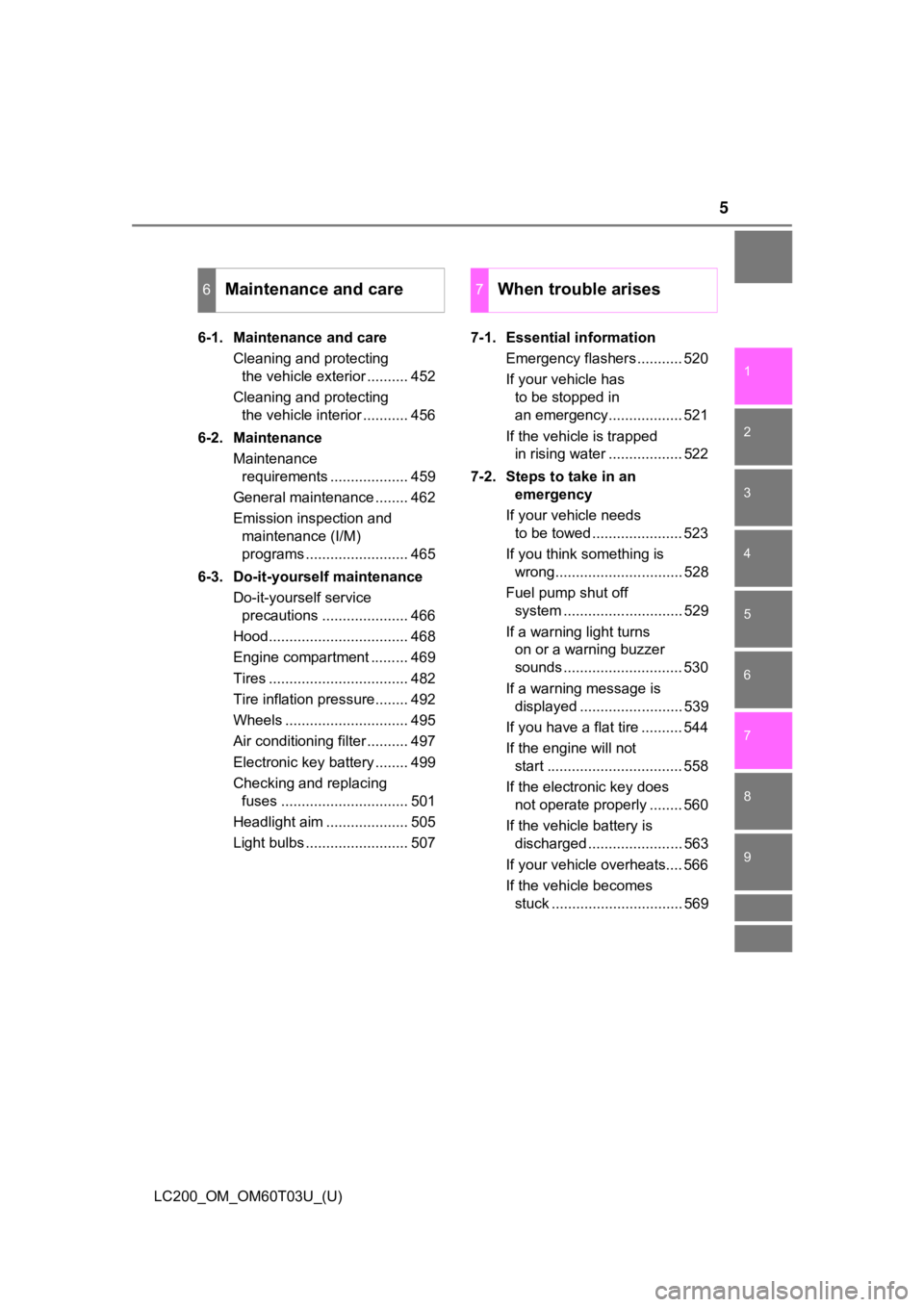
5
1
8 7
6
5
4
3
2
LC200_OM_OM60T03U_(U)
9
6-1. Maintenance and careCleaning and protecting the vehicle exterior .......... 452
Cleaning and protecting the vehicle interior ........... 456
6-2. Maintenance Maintenance requirements ................... 459
General maintenance ........ 462
Emission inspection and maintenance (I/M)
programs ......................... 465
6-3. Do-it-yourself maintenance Do-it-yourself service precautions ..................... 466
Hood.................................. 468
Engine compartment ......... 469
Tires .................................. 482
Tire inflation pressure........ 492
Wheels .............................. 495
Air conditioning filter .......... 497
Electronic key battery ........ 499
Checking and replacing fuses ............................... 501
Headlight aim .................... 505
Light bulbs ......................... 507 7-1. Essential information
Emergency flashers ........... 520
If your vehicle has to be stopped in
an emergency.................. 521
If the vehicle is trapped in rising water .................. 522
7-2. Steps to take in an emergency
If your vehicle needs to be towed ...................... 523
If you think something is wrong............................... 528
Fuel pump shut off system ............................. 529
If a warning light turns on or a warning buzzer
sounds ............................. 530
If a warning message is displayed ......................... 539
If you have a flat tire .......... 544
If the engine will not start ................................. 558
If the electronic key does not operate properly ........ 560
If the vehicle battery is discharged ....................... 563
If your vehicle overheats.... 566
If the vehicle becomes stuck ................................ 569
6Maintenance and care7When trouble arises
Page 433 of 632
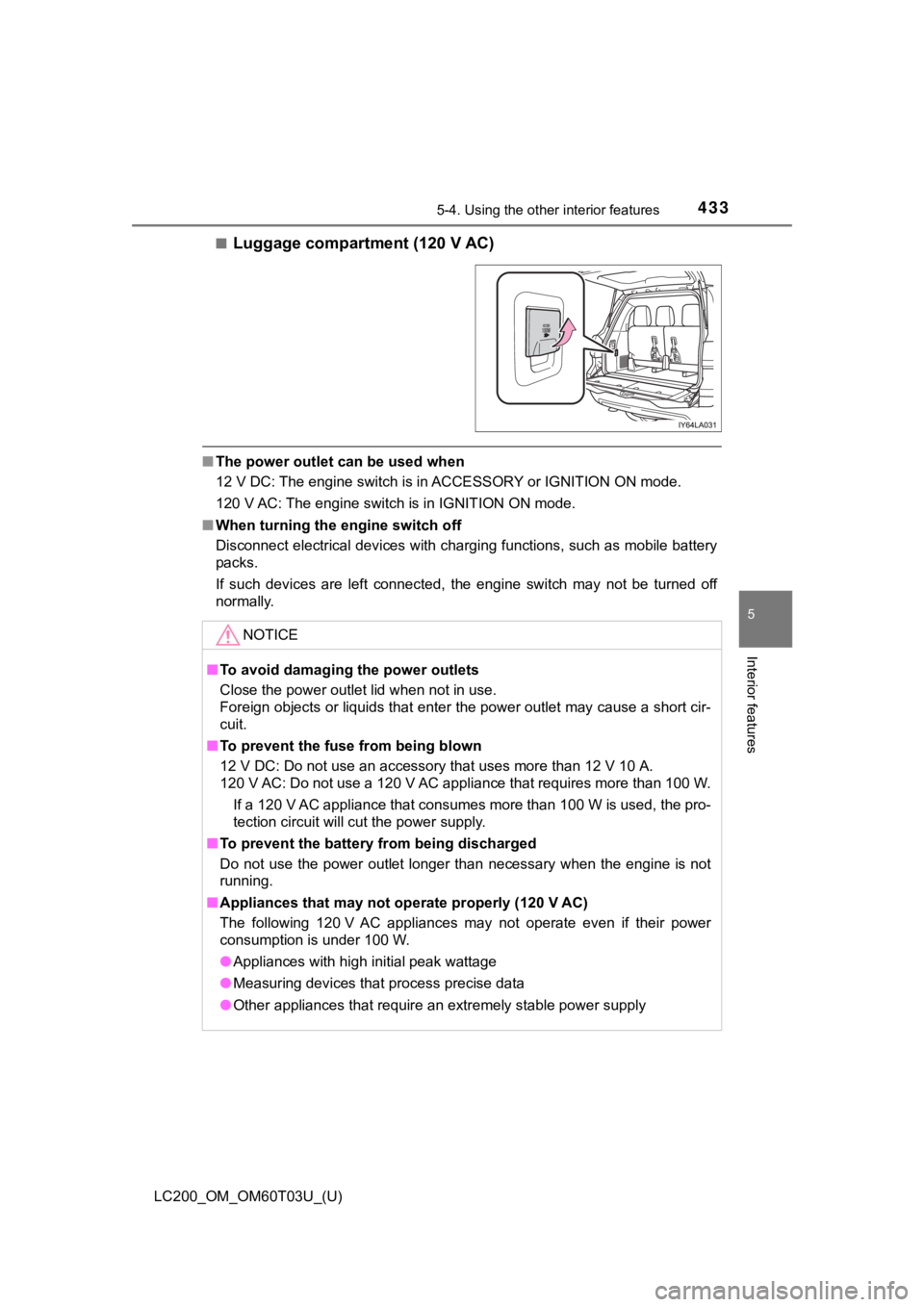
LC200_OM_OM60T03U_(U)
4335-4. Using the other interior features
5
Interior features
■Luggage compartment (120 V AC)
■The power outlet can be used when
12 V DC: The engine switch is in ACCESSORY or IGNITION ON mode.
120 V AC: The engine switch is in IGNITION ON mode.
■ When turning the engine switch off
Disconnect electrical devices with charging functions, such as mobile battery
packs.
If such devices are left connected, the engine switch may not be turned off
normally.
NOTICE
■ To avoid damaging the power outlets
Close the power outlet lid when not in use.
Foreign objects or liquids that enter the power outlet may caus e a short cir-
cuit.
■ To prevent the fuse from being blown
12 V DC: Do not use an accessory that uses more than 12 V 10 A.
120 V AC: Do not use a 120 V AC appliance that requires more than 100 W.
If a 120 V AC appliance that consumes more than 100 W is used, th e pro-
tection circuit will cut the power supply.
■ To prevent the battery from being discharged
Do not use the power outlet longer than necessary when the engi ne is not
running.
■ Appliances that may not operate properly (120 V AC)
The following 120 V AC appliances may not operate even if their power
consumption is under 100 W.
● Appliances with high initial peak wattage
● Measuring devices that process precise data
● Other appliances that require an extremely stable power supply
Page 451 of 632
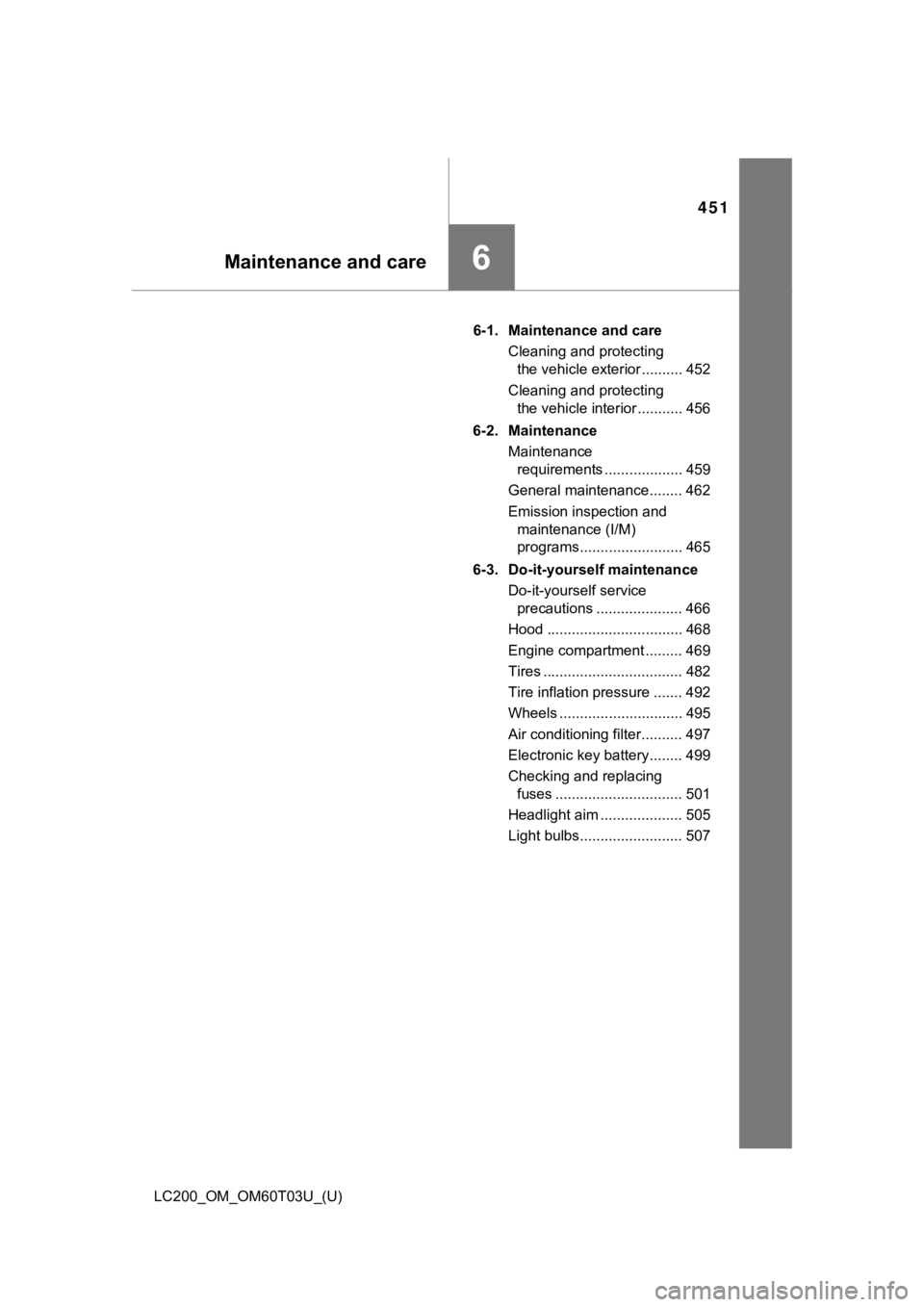
451
LC200_OM_OM60T03U_(U)
6Maintenance and care
6-1. Maintenance and careCleaning and protecting the vehicle exterior .......... 452
Cleaning and protecting the vehicle interior ........... 456
6-2. Maintenance Maintenance requirements ................... 459
General maintenance........ 462
Emission inspection and maintenance (I/M)
programs......................... 465
6-3. Do-it-yourself maintenance Do-it-yourself service precautions ..................... 466
Hood ................................. 468
Engine compartment ......... 469
Tires .................................. 482
Tire inflation pressure ....... 492
Wheels .............................. 495
Air conditioning filter.......... 497
Electronic key battery........ 499
Checking and replacing fuses ............................... 501
Headlight aim .................... 505
Light bulbs......................... 507
Page 466 of 632
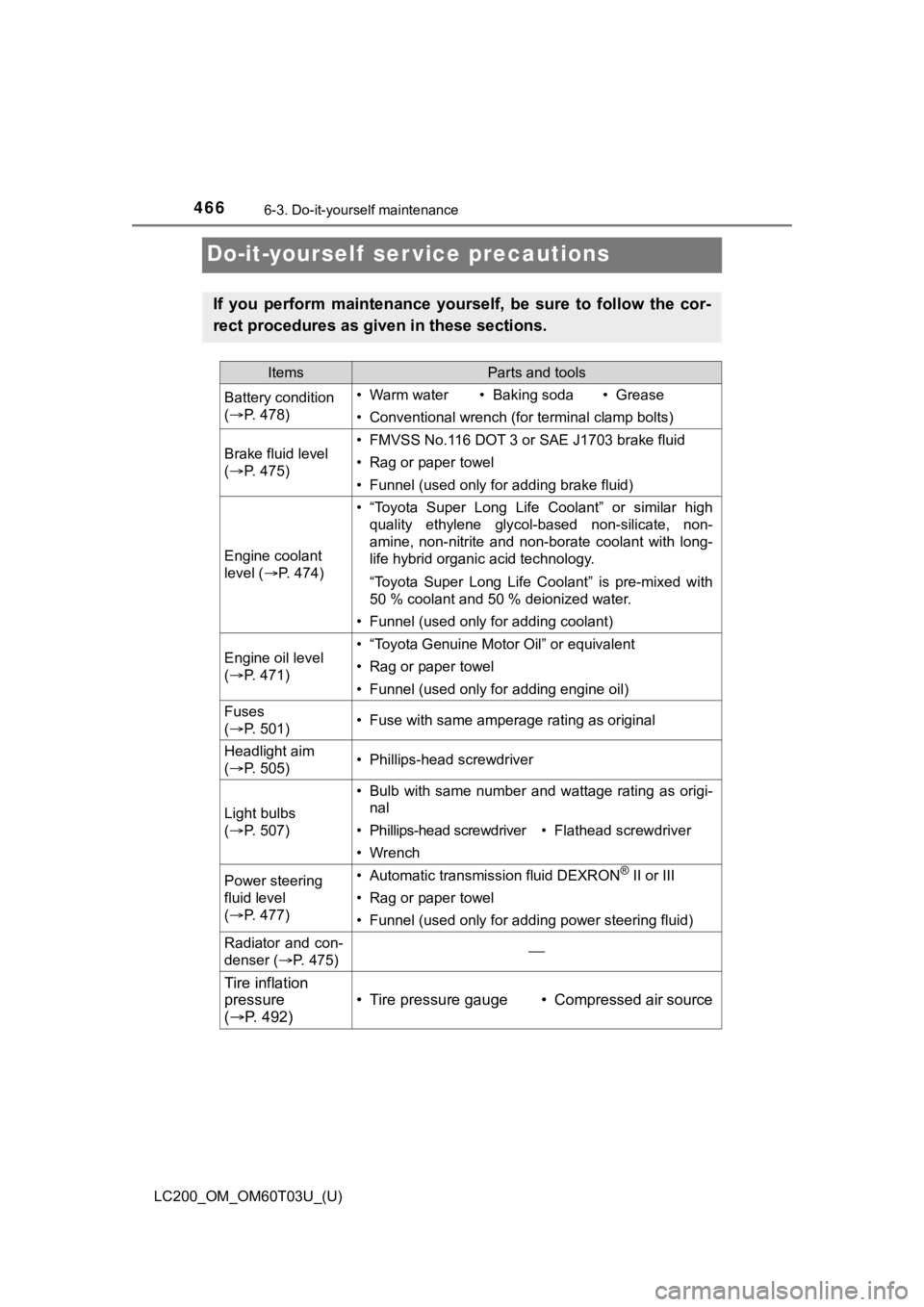
466
LC200_OM_OM60T03U_(U)
6-3. Do-it-yourself maintenance
Do-it-yourself ser vice precautions
If you perform maintenance yourself, be sure to follow the cor-
rect procedures as given in these sections.
ItemsParts and tools
Battery condition
( P. 4 7 8 )• Warm water• Baking soda• Grease
• Conventional wrench (for terminal clamp bolts)
Brake fluid level
( P. 4 7 5 )• FMVSS No.116 DOT 3 or SAE J1703 brake fluid
• Rag or paper towel
• Funnel (used only for adding brake fluid)
Engine coolant
level ( P. 474)
• “Toyota Super Long Life Coolant” or similar high
quality ethylene glycol-based non-silicate, non-
amine, non-nitrite and non-borate coolant with long-
life hybrid organic acid technology.
“Toyota Super Long Life Coolant” is pre-mixed with
50 % coolant and 50 % deionized water.
• Funnel (used only for adding coolant)
Engine oil level
( P. 4 7 1 )• “Toyota Genuine Motor Oil” or equivalent
• Rag or paper towel
• Funnel (used only for adding engine oil)
Fuses
( P. 5 0 1 )• Fuse with same amperage rating as original
Headlight aim
( P. 5 0 5 )• Phillips-head screwdriver
Light bulbs
( P. 5 0 7 )
• Bulb with same number and wattage rating as origi-
nal
• Phillips-head screwdriver• Flathead screwdriver
• Wrench
Power steering
fluid level
( P. 4 7 7 )• Automatic transmission fluid DEXRON® II or III
• Rag or paper towel
• Funnel (used only for adding power steering fluid)
Radiator and con-
denser ( P. 475)
Tire inflation
pressure
( P. 492)
• Tire pressure gauge• Compressed air source
Page 469 of 632
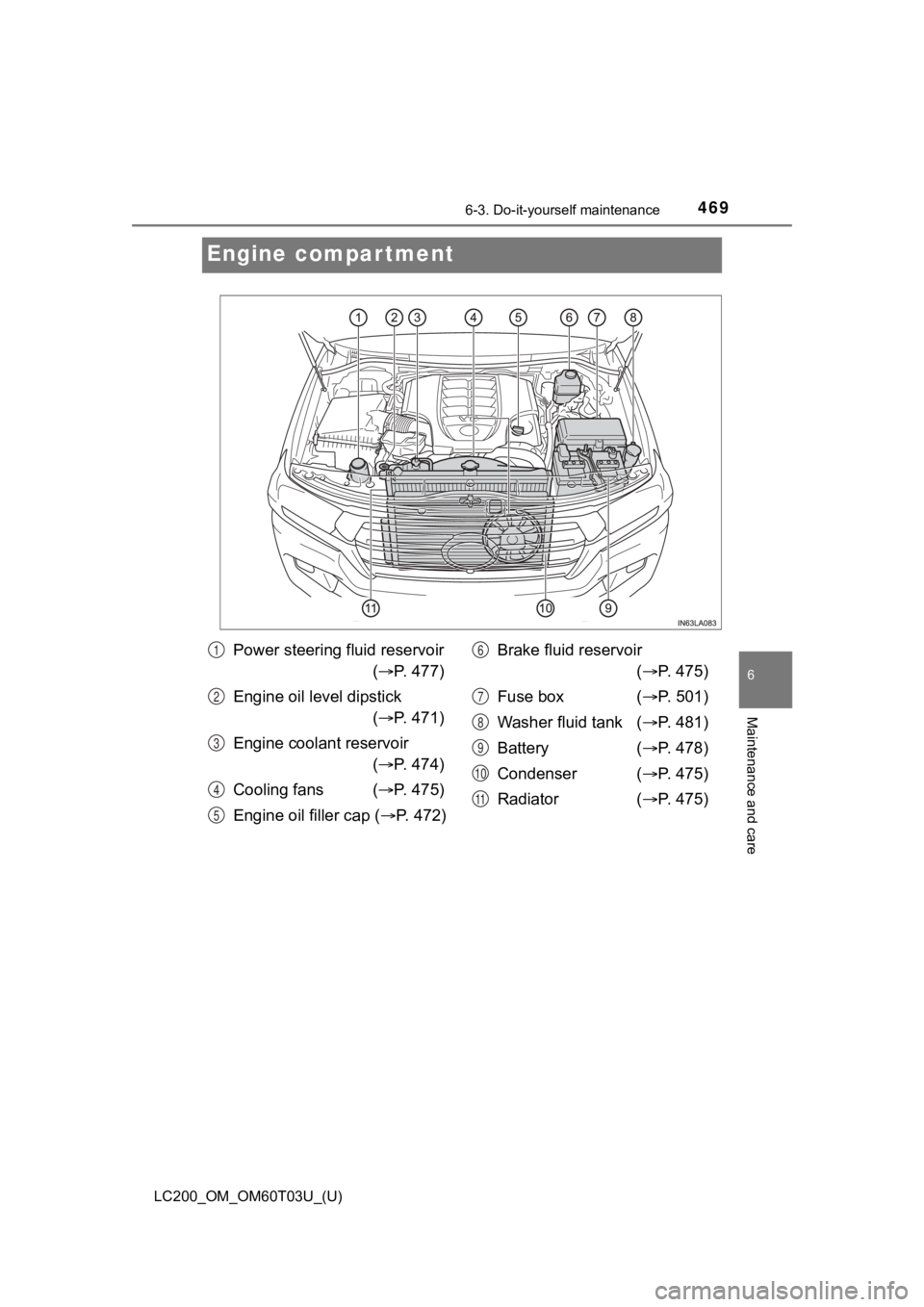
469
LC200_OM_OM60T03U_(U)
6-3. Do-it-yourself maintenance
6
Maintenance and care
Engine compartment
Power steering fluid reservoir( P. 477)
Engine oil level dipstick ( P. 471)
Engine coolant reservoir ( P. 474)
Cooling fans ( P. 475)
Engine oil filler cap ( P. 472) Brake fluid reservoir
( P. 475)
Fuse box ( P. 501)
Washer fluid tank ( P. 481)
Battery ( P. 478)
Condenser ( P. 475)
Radiator ( P. 475)1
2
3
4
5
6
7
8
9
10
11
Page 501 of 632
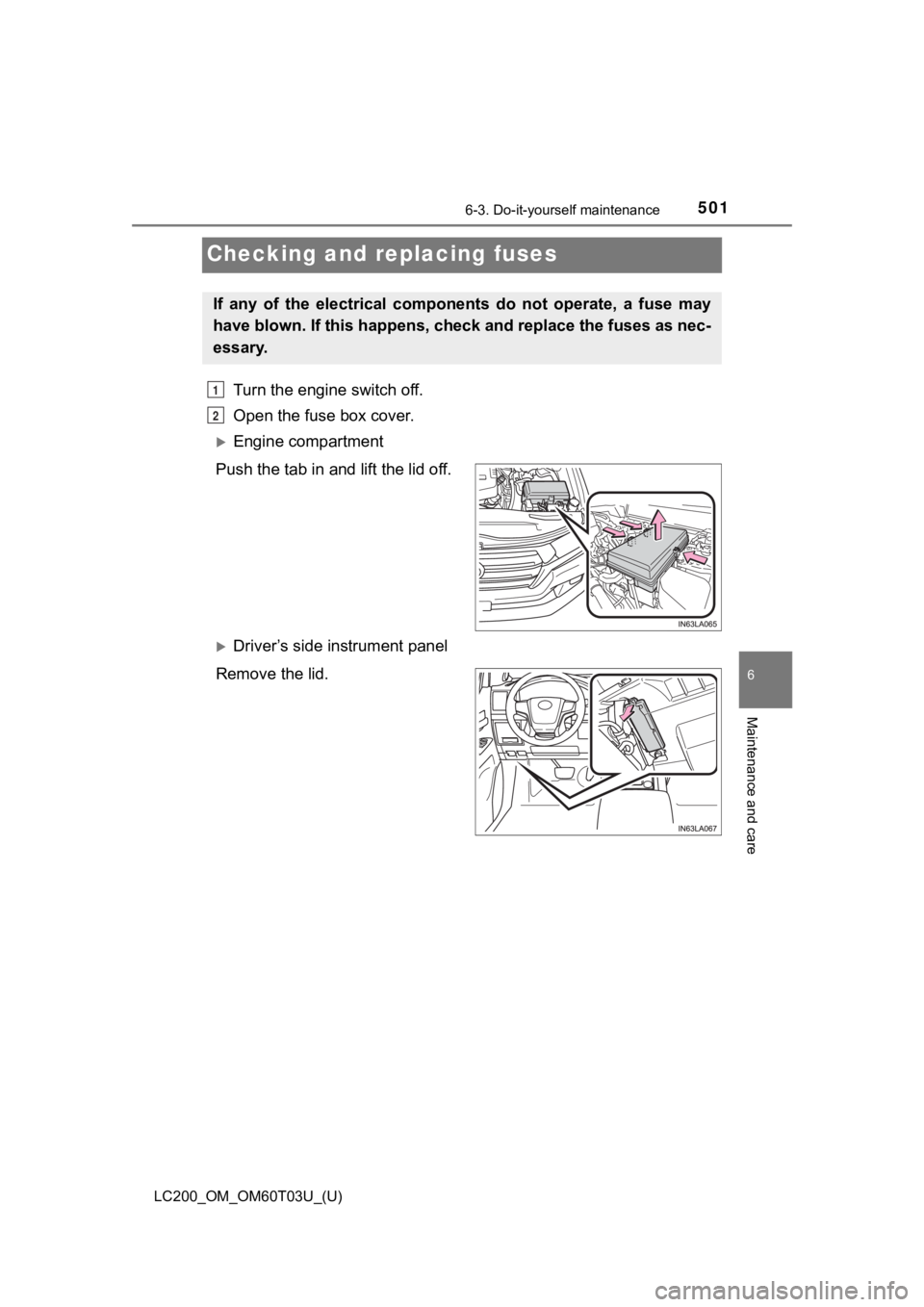
501
LC200_OM_OM60T03U_(U)
6-3. Do-it-yourself maintenance
6
Maintenance and care
Checking and replacing fuses
Turn the engine switch off.
Open the fuse box cover.
Engine compartment
Push the tab in and lift the lid off.
Driver’s side instrument panel
Remove the lid.
If any of the electrical components do not operate, a fuse may
have blown. If this happens, che ck and replace the fuses as nec-
essary.
1
2
Page 502 of 632

502
LC200_OM_OM60T03U_(U)
6-3. Do-it-yourself maintenance
Passenger’s side instrument panel
Remove the cover.
Remove the lid.
Remove the fuse with the pull-out tool.
Only type A fuse can be
removed using the pull-out tool.
3
Page 503 of 632
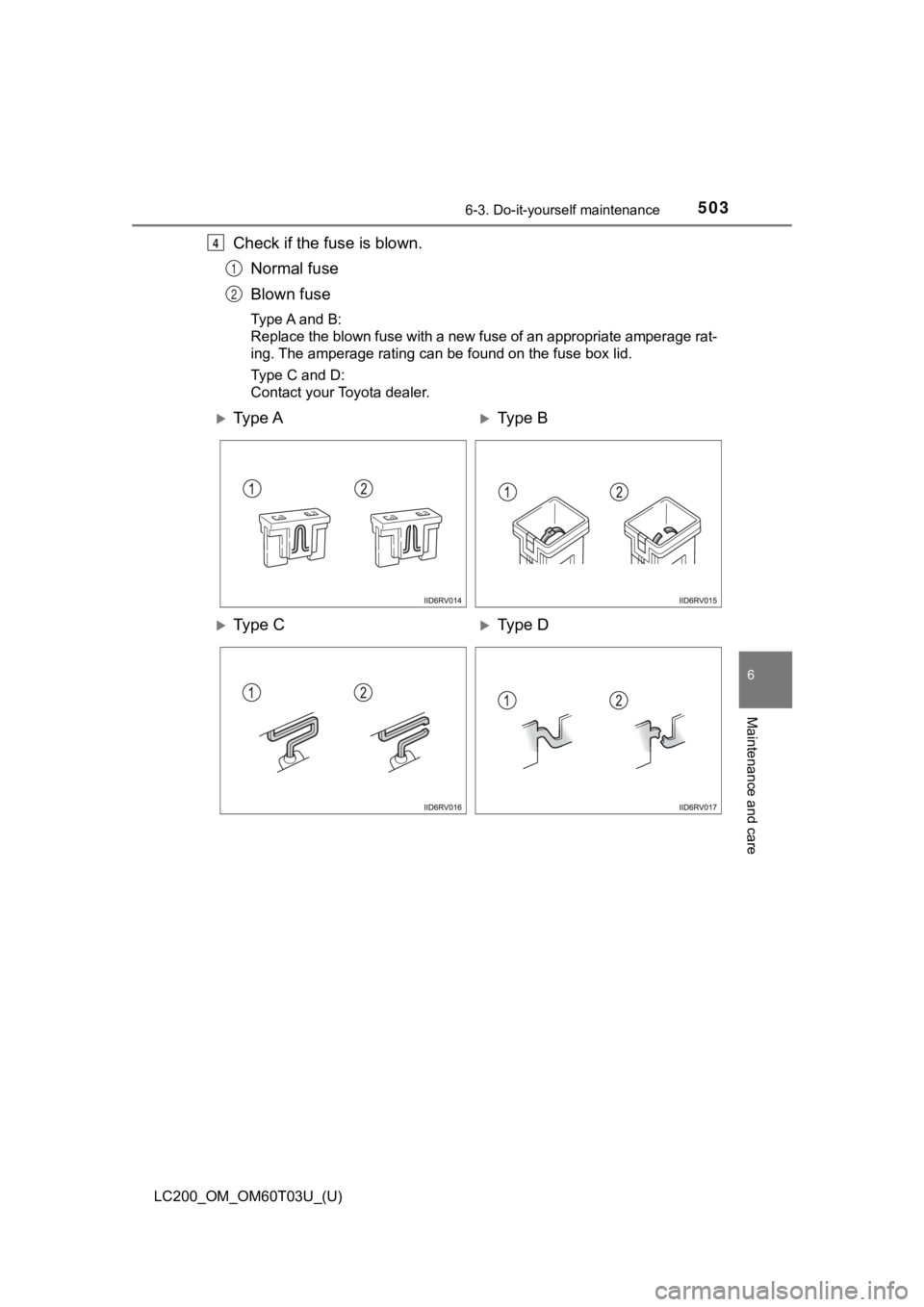
LC200_OM_OM60T03U_(U)
5036-3. Do-it-yourself maintenance
6
Maintenance and care
Check if the fuse is blown.Normal fuse
Blown fuse
Type A and B:
Replace the blown fuse with a new fuse of an appropriate ampera ge rat-
ing. The amperage rating can be found on the fuse box lid.
Type C and D:
Contact your Toyota dealer.
4
1
2
Ty p e AType B
Ty p e CType D
Page 504 of 632
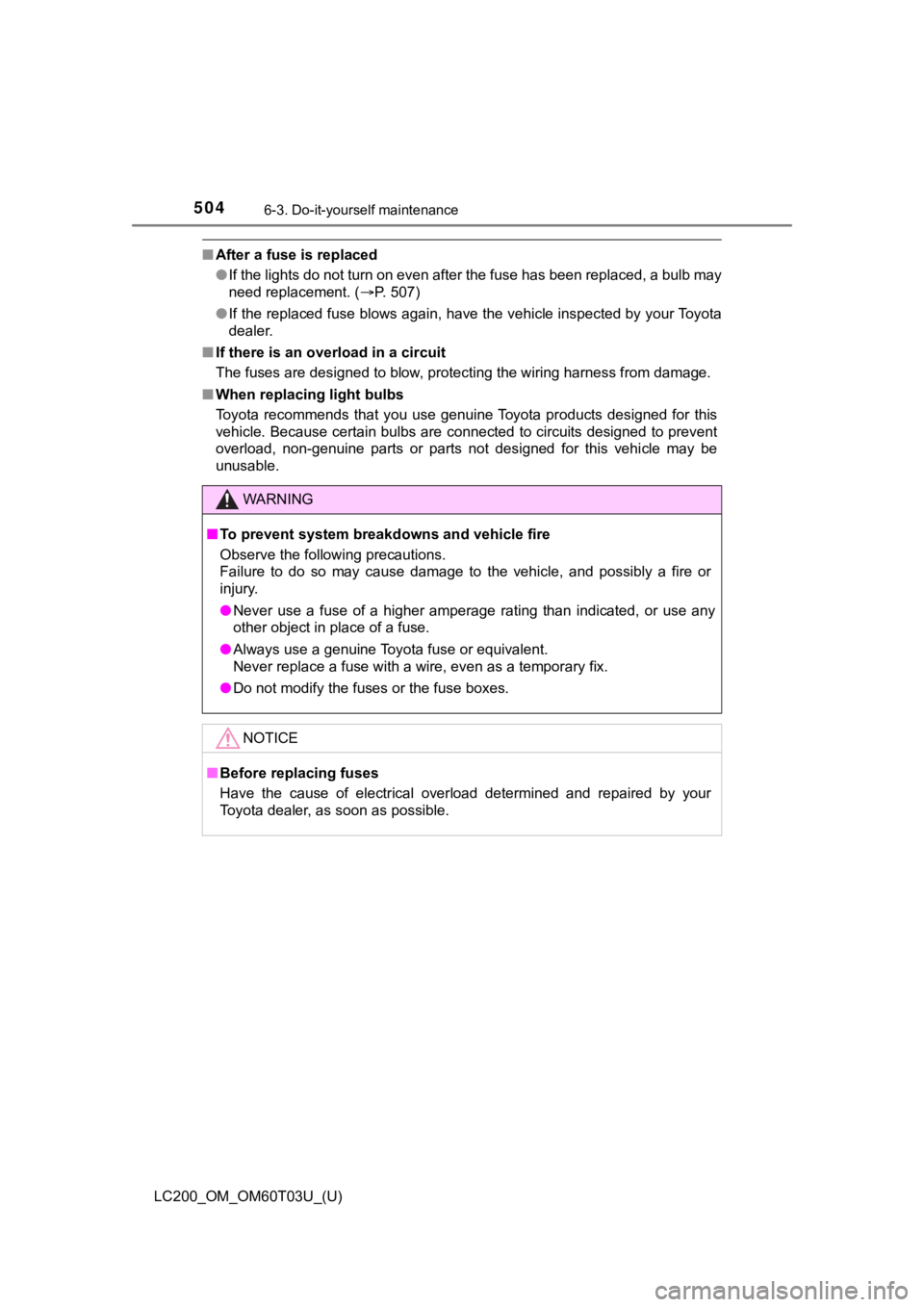
504
LC200_OM_OM60T03U_(U)
6-3. Do-it-yourself maintenance
■After a fuse is replaced
●If the lights do not turn on even after the fuse has been repla ced, a bulb may
need replacement. ( P. 507)
● If the replaced fuse blows again, have the vehicle inspected by your Toyota
dealer.
■ If there is an overload in a circuit
The fuses are designed to blow, protecting the wiring harness f rom damage.
■ When replacing light bulbs
Toyota recommends that you use genuine Toyota products designed for this
vehicle. Because certain bulbs are connected to circuits designed to prevent
overload, non-genuine parts or parts not designed for this vehicle may be
unusable.
WARNING
■ To prevent system breakdowns and vehicle fire
Observe the following precautions.
Failure to do so may cause damage to the vehicle, and possibly a fire or
injury.
● Never use a fuse of a higher amperage rating than indicated, or use any
other object in place of a fuse.
● Always use a genuine Toyota fuse or equivalent.
Never replace a fuse with a wire, even as a temporary fix.
● Do not modify the fuses or the fuse boxes.
NOTICE
■Before replacing fuses
Have the cause of electrical overload determined and repaired b y your
Toyota dealer, as soon as possible.
Page 558 of 632
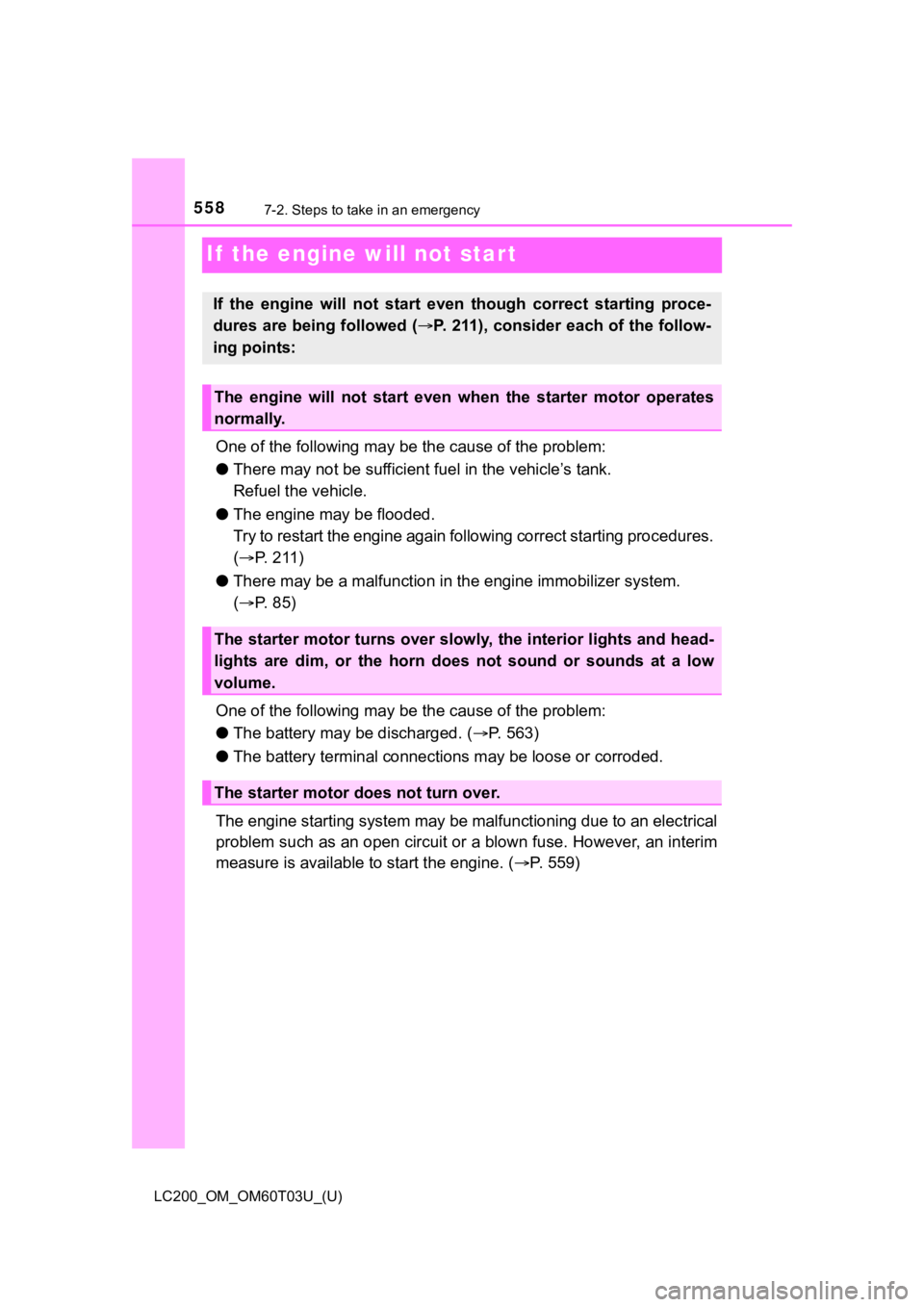
558
LC200_OM_OM60T03U_(U)
7-2. Steps to take in an emergency
If the engine will not star t
One of the following may be the cause of the problem:
● There may not be sufficient f uel in the vehicle’s tank.
Refuel the vehicle.
● The engine may be flooded.
Try to restart the engine again following correct starting proc edures.
( P. 211)
● There may be a malf unction in the engine immobilizer system.
( P. 85)
One of the following may be the cause of the problem:
● The battery may be discharged. ( P. 563)
● The battery terminal connecti ons may be loose or corroded.
The engine starting system may be malfunctioning due to an elec trical
problem such as an open circuit or a blown fuse. However, an in terim
measure is available to start the engine. ( P. 559)
If the engine will not start eve n though correct starting proce -
dures are being followed ( P. 211), consider each of the follow-
ing points:
The engine will not start even wh en the starter motor operates
normally.
The starter motor turns over slowly, the interior lights and he ad-
lights are dim, or the horn does not sound or sounds at a low
volume.
The starter motor d oes not turn over.